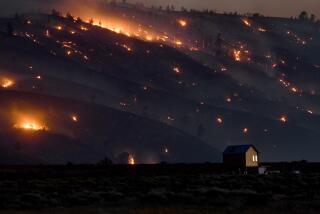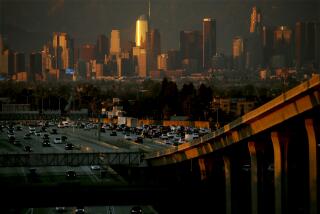Windblown soot, gas and dust pose threats
Health officials urged the young, the elderly and those with breathing problems to stay indoors until further notice as Southern California’s wildfires continued to pollute the air with smoke, gas and dust.
Even healthy adults were told to avoid exerting themselves outdoors, while schools from San Diego to San Bernardino were urged to cancel open-air gym classes -- a recommendation that schools in Los Angeles and Long Beach quickly followed.
“We’re doing this because the air quality is deteriorating,” said Jonathan Fielding, director of Los Angeles County Department of Public Health.
Gray plumes of smoke that were visible from space blanketed San Diego and Malibu on Monday and launched a haze of soot particles into the atmosphere. Officials warned that the tiniest particles posed the greatest health risk and threatened to aggravate emphysema, asthma, heart disease and other medical conditions.
“The very small particles are the ones that can penetrate deeper in the lungs and have harsher health effects,” said Michael Kleinman, professor of community and environmental medicine at UC Irvine. These “particles, when deposited in the lungs, can cause tissue damage, inflammation and irritation. They can also penetrate and enter the bloodstream and change the way that blood coagulates, so people at highest risk of stroke have worse problems.”
People and pets alike headed indoors at the site of falling ash. Even the San Diego Chargers canceled workouts.
Those residents who found themselves in the path of billowing smoke plumes improvised their own protective gear.
In Foothill Ranch, a community in Lake Forest, teenagers strapped on ski goggles and draped bandannas over their faces to temper the sting of smoke. Some people handed out gauze masks to their teary-eyed neighbors.
Air quality officials said it was rare for so many Southern California communities to be affected at the same time.
“What we’re seeing today is a combination of smoke from the many wildfires, as well as dust that’s being kicked up by high winds,” said Sam Atwood, a spokesman for the South Coast Air Quality Management District. “This is obviously a very large-scale event that is affecting our entire four-county region in air quality.”
The district, which encompasses Los Angeles, Orange, Riverside and San Bernardino counties, issued “unhealthy” and “very unhealthy” air quality readings in regions close to fires or downwind of them.
Individuals who experienced difficulty breathing were advised to contact their doctor, while those with asthma were urged to keep their inhalers within reach.
For some, bad air was reason enough to get away. Kalpana Singh Rhodes, her husband, three children and father spent Monday preparing to leave their home in La Jolla. Their plan was to stay with relatives in Seattle.
Singh Rhodes, 34, said she was worried about her father’s weak heart and her middle child’s breathing difficulties. Both were coughing.
“I’m laboring, and I’m the healthy one,” Singh Rhodes said. “My backyard is full of ash. We thought it was pollen. Now there are big, long fingers of ash, like cinders.”
Singh Rhodes said she went to a Home Depot at 8 a.m. to buy air purifiers, but found the shelves empty. She persuaded a manager to sell her three floor models. By afternoon, she decided that no air purifier would help.
Health officials stressed that the smell of smoke alone was not cause for concern, but that people living near the wildfires or fields of soot should exercise the most caution, because they were more likely to be exposed to carbon monoxide.
The San Bernardino Department of Public Health asked residents to be vigilant about smoke levels as a result of the Grass Valley fire in Lake Arrowhead and the Walker fire in Ontario. People were urged to wear eye protection and to resist rubbing their eyes. They should let their tears wash the irritants away instead, officials said.
Times staff writers Tony Barboza and Nardine Saad contributed to this report.
More to Read
Start your day right
Sign up for Essential California for news, features and recommendations from the L.A. Times and beyond in your inbox six days a week.
You may occasionally receive promotional content from the Los Angeles Times.







